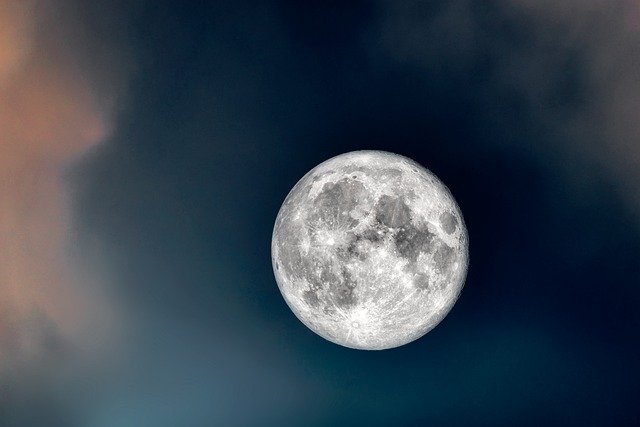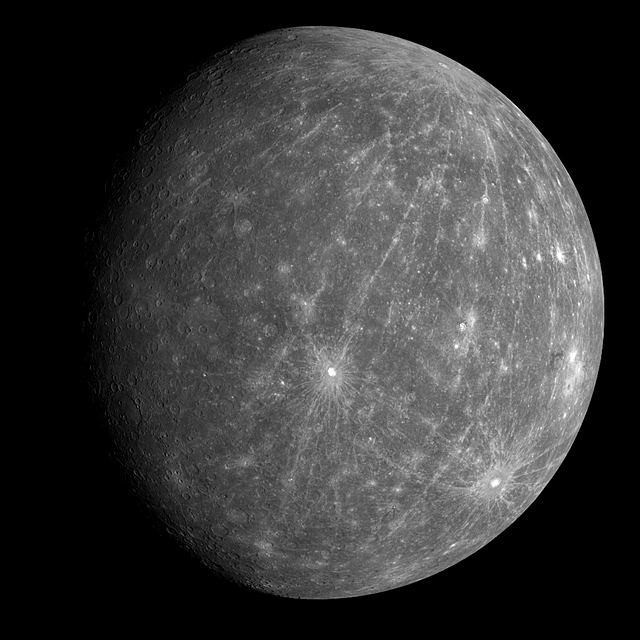*This post may contain affiliate links. This means we may make a commission if you purchase an item using one of our links*
The main differences between the Moon and Mercury is that the moon is a natural satellite that orbits another planet whilst Mercury is a terrestrial planet that only orbits the Sun, Mercury is the bigger of the two with a diameter of 4,879km compared to the Moon’s 3,474.8km and Mercury is naturally hotter considering it is the closest planet to the Sun averaging 167°C whereas the Moon’s peak is only 127°C in comparison.
There are numerous other differences between The Moon and Mercury so, continue reading for a more thorough breakdown of these differences below.
What Is The Moon?
Table of Contents

The Moon is the gray celestial being that orbits our Earth. It is also tidally locked to Earth meaning that we only see one side of it at any given time across our skyline.
It takes the moon roughly 27 days to complete an orbit around Earth, which it does in an elliptical pattern. The Moon’s axial tilt is very straight at 1.5 degrees. As a result of the tidally locked status along with the effects that Earth has on Its general rotational patterns, it takes the Moon roughly 29.5 days to complete a day.
In regards to its temperature, it fluctuates where it can be really hot at 127 degrees Celsius when the Sun is shining on it and as low as -173 degrees in areas where the Sun does not strike it. It’s core on the other hand is far hotter ranging between 1,327 to 1,427 degrees Celsius.
This is as a result of the lunar entity’s extremely thin to practically non-existent atmosphere, which not only results in these massive temperature shifts but, is also the reason why it has over 100,000 craters on its surface.
Speaking of the Moon’s surface, the entity is mostly made of rocks, iron, magnesium much like most of the other moons and terrestrial based planets in our solar system.
It is among the bigger moons in our solar system with a diameter of 3,474.8km and a mass of 7.35 × 10^22 kg, which actually places it fifth amongst all moons in our solar system and would also make it bigger than the dwarf planet Pluto.
Despite all the advancements in technology, the last time a manned mission was made to the Moon was on the Apollo 17 way back in December 1972 and no further missions have been done since, possibly as result of the political agendas behind the numerous countries vying for opportunities that involve the Moon that we don’t know of.
What Is The Planet Mercury?

Mercury is the planet closest to our Sun and would fall under the terrestrial planet moniker. Out of the 8 main line planets Mercury is also the smallest, coming in at 4,879km.
This planet is known for having its fair share of craters, which is mostly down to its thinner non protective atmosphere that is unable to stop interstellar debris from striking its surface.
Despite its close proximity to the Sun, Mercury is not the hottest planet in our solar system but, it does come in second, just behind Venus. It’s surface temperature is around 430 degrees on the upper end with the average temperature around 167 degrees Celsius whereas its core is far hotter at around 1,600 – 3,000 degrees Celsius.
Due to it close proximity to our local star, Mercury is unable to sustain a moon around its orbit and even has a very unique rotation around the Sun where it has 3:2 orbital resonance with the Sun.
As for how long it takes for the planet to rotate around our yellow dwarf star, its the shortest time period of 88 days for obvious reasons, whilst a single day on the planet takes 58.65 Earth days to complete. Its axial tilt is only 2 degrees to the right, making it amongst the straightest planets in the solar system too.
How Are The Moon And Mercury Similar?
The Moon and Mercury do have a few similarities, which in this case includes the following:
- Both have a hotter central core.
- Both are a spherical in shape.
- Both have a rocky surface.
- Both have no rings surrounding them.
- Neither have any other moon like objects orbiting it.
- Both have thin atmospheres.
Differences Between The Moon And Mercury
In regards to the differences between the two, they include the following:
- Mercury orbits the Sun in a circular pattern whilst the Moon orbits Earth in an elliptical pattern.
- Mercury is a terrestrial planet whilst the Moon is a natural satellite.
- Mercury is the closest planet to the Sun whilst the Moon is joint 3rd with Earth. As a result it takes Mercury 88 days to complete an orbit around the Sun and 365 days for the Moon to do the same.
- A day on Mercury takes 58.65 days whilst the Moon completes a day in 29.5 days.
- The Moon has an axial tilt of 1.5 degrees whilst Mercury’s axial tilt is 2 degrees.
- Mercury is the hotter of the two, achieving an average temperature of 167 degrees Celsius whilst the Moon’s highest temperature is around 127 degrees Celsius and can dip as low as -173 degrees Celsius.
- in regards to core temperatures, Mercury is still the hotter of the two with a temperature of 1,600 – 3,000 degrees Celsius whilst the Moon has a temperature of 1,327 – 1,427 degrees Celsius.
- The Moon is the smaller of the two with a diameter of 3,474.8km whilst Mercury has a diameter of 4,879km.
- As for their masses, the Moon’s mass is 7.35 × 10^22 kg whilst Mercury has a mass of 3.285 × 10^23 kg.
- Mercury’s gravity is more than 2 times that of the Moon.
Summary
Mercury may share some similarities with the Moon such as their extremely thin atmosphere, lack of other objects orbiting them and their general composition but, these similarities don’t mean too much.
This is because .Mercury is one of the 8 main line planets in our solar system and the other one of 200+ natural satellite that orbits another planet. Mercury is also bigger, hotter and the older of the two too so despite their similarities, they are very different when it comes to how they function and operate within our solar system.

